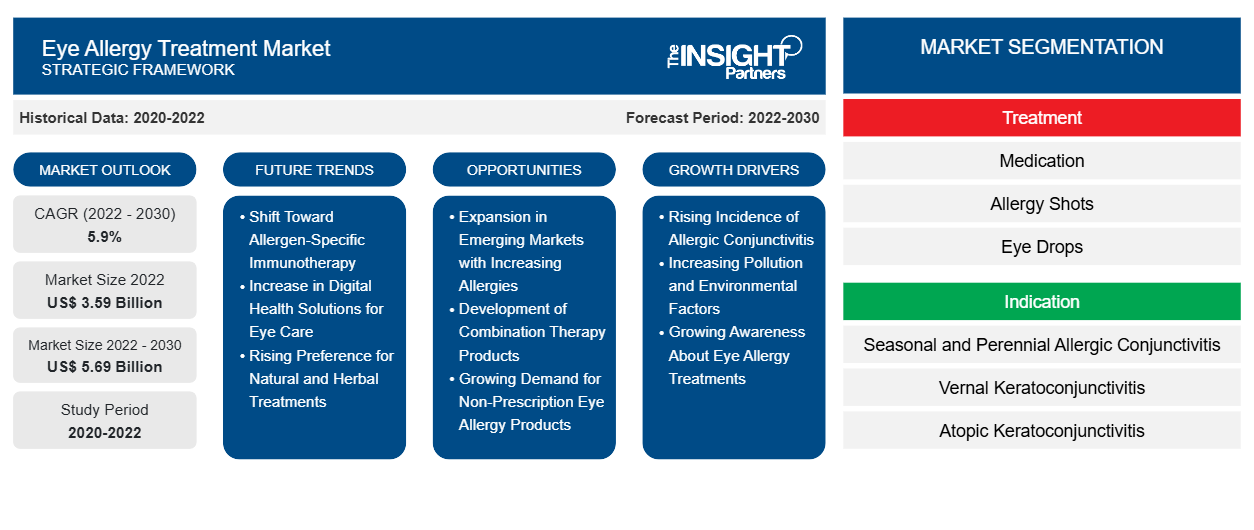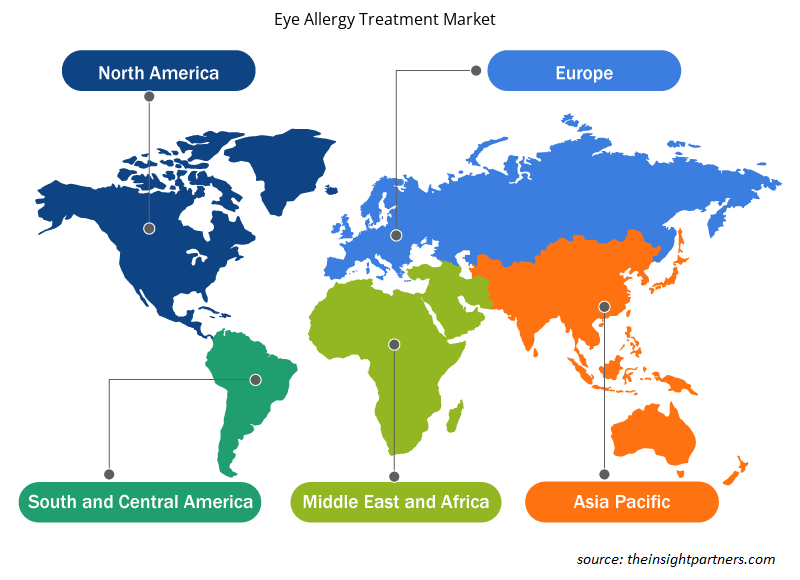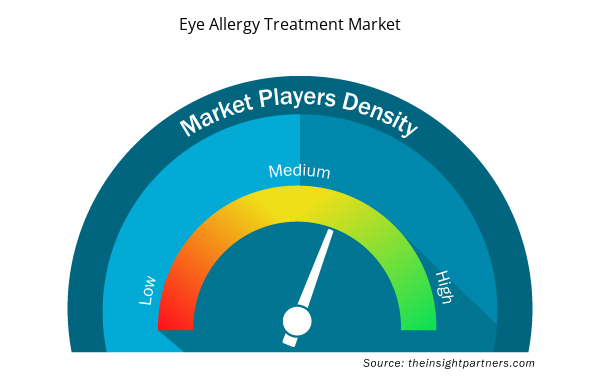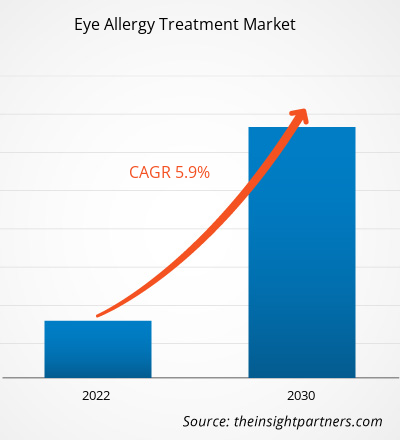[Research Report] The eye allergy treatment market size is projected to reach US$ 5.69 billion by 2030 from US$ 3.59 billion in 2022; it is estimated to record a CAGR of 5.9% during 2022–2030.
Market Insights and Analyst View:
Eye allergy treatment includes over-the-counter medications and prescription drugs used to alleviate symptoms such as redness, itching, tearing, and swelling of the eyes. Some of the commonly used products include antihistamine eye drops, mast cell stabilizers, and combination therapies. Primary types of eye allergy are seasonal or perennial allergic conjunctivitis, vernal keratoconjunctivitis, atopic keratoconjunctivitis, and contact allergic conjunctivitis. The increasing prevalence of eye allergies worldwide and the availability of over-the-counter solutions favor the eye allergy treatment market growth.
Growth Drivers:
Eye allergies, also known as allergic conjunctivitis, are triggered by pollen, dust, animals, and mold. Rising levels of air pollution have contributed to the growing incidences of eye allergies. In addition, changes in lifestyle and dietary habits, increased exposure to allergens, increased screen time leading to eye strain, and increased susceptibility to eye discomfort have contributed to a substantial rise in eye allergic reactions among the global population.
As per a study titled “A Contemporary Look at Allergic Conjunctivitis,” published in 2020, allergic eye disease is a common issue among the North American population. It affects nearly 40% of the population, and this number is growing. Half of the US population who suffer ocular allergy symptoms require medication for relief. Still, only a fraction of them use prescription medications, making the development of these new treatments especially attractive.
Eye allergy treatment includes products and solutions that are used to treat and manage allergies affecting the eyes. Treatment includes over-the-counter medications and prescription drugs used to alleviate symptoms such as redness, itching, tearing, and swelling of the eyes. Some commonly used products include antihistamine eye drops, mast cell stabilizers, and nonsteroidal anti-inflammatory drugs. The growth in the number of people experiencing eye allergies leads to a higher demand for treatment options. This increased the demand for treatment choices, thereby driving the eye allergy treatment market growth.
The eye allergy treatment market trends include the development of combination therapies that will favor the growth of the market in the future.
Customize This Report To Suit Your Requirement
You will get customization on any report - free of charge - including parts of this report, or country-level analysis, Excel Data pack, as well as avail great offers and discounts for start-ups & universities
Eye Allergy Treatment Market: Strategic Insights

- Get Top Key Market Trends of this report.This FREE sample will include data analysis, ranging from market trends to estimates and forecasts.
Customize This Report To Suit Your Requirement
You will get customization on any report - free of charge - including parts of this report, or country-level analysis, Excel Data pack, as well as avail great offers and discounts for start-ups & universities
Eye Allergy Treatment Market: Strategic Insights

- Get Top Key Market Trends of this report.This FREE sample will include data analysis, ranging from market trends to estimates and forecasts.
Report Segmentation and Scope:
The eye allergy treatment market analysis has been carried out by considering the following segments: treatment, indication, distribution channel, and geography. Based on treatment, the market is categorized into medication, allergy shots, and eye drops. In terms of indication, the market is classified into seasonal and perennial allergic conjunctivitis, vernal keratoconjunctivitis, atopic keratoconjunctivitis, contact allergic conjunctivitis, and giant papillary conjunctivitis. In terms of distribution channels, the market is segmented into hospital pharmacies, online pharmacies, and drug stores.
The scope of the eye allergy treatment market report covers North America (the US, Canada, and Mexico), Europe (France, Germany, the UK, Spain, Italy, and the Rest of Europe), Asia Pacific (China, Japan, India, South Korea, Australia, and the Rest of Asia Pacific), the Middle East & Africa (Saudi Arabia, the UAE, South Africa, and the Rest of Middle East & Africa), and South & Central America (Brazil, Argentina, and the Rest of South & Central America).
Segmental Analysis:
The eye allergy treatment market, by treatment, is categorized into medication, allergy shots, and eye drops. The eye drops segment held a significant market share in 2022. It is anticipated to record the highest CAGR in the market during 2022–2030.
Based on indication, the market is categorized into seasonal and perennial allergic conjunctivitis, vernal keratoconjunctivitis, atopic keratoconjunctivitis, contact allergic conjunctivitis, and giant papillary conjunctivitis. The seasonal and perennial allergic conjunctivitis segment held a significant eye allergy treatment market share in 2022 and is estimated to register the highest CAGR during 2022–2030.
Based on distribution channels, the market is segmented into hospital pharmacies, online pharmacies, and drug stores. The hospital pharmacies segment held a significant eye allergy treatment market share in 2022. In addition, the online pharmacy segment is expected to register the highest CAGR during 2022–2030.
Regional Analysis:
Based on geography, the eye allergy treatment market report is primarily divided into North America, Europe, Asia Pacific, South & Central America, and the Middle East & Africa. In 2022, North America captured a significant share of the market. In 2022, the US held the largest share of the market in the region. The market growth in North America is attributed to the availability of modern healthcare infrastructure, the strong presence of key market players, the growing number of eye allergies and dry eye diseases, and the introduction of cutting-edge medications. According to Baptist Health, nearly 50 million Americans have some form of seasonal allergy. About 30% of all adults and 40% of all children experience allergic reactions affecting eyes, eyelids, and tear ducts.
A dry eye can lead to eye allergies, which will consequently result in dry eye disease. Dry eye disease is a common, although underdiagnosed disorder in the US. According to the National Health and Wellness Survey data published in 2020, 6.8% of the adult population in the US was diagnosed with dry eye. According to an article, ‘Risk factors for ocular surface damage in Mexican patients with dry eye disease: a population-based study,’ published in 2019, nearly 58% of people complained about dry eyes.
Pharmaceutical companies are improving access to specialized treatments, such as allergy-relieving eye drops, to expand their reach in the region. From March 2022, Allergan’s LASTACAFT (alcaftadine ophthalmic solution 0.25%) was available to Americans with ocular allergies without a prescription. Following the recent US Food and Drug Administration approval of a complete prescription to over-the-counter switch, the original patented prescription-strength formulation of LASTACAFT can be found online and in retail stores where OTC eye drops are sold. Thus, the factors mentioned above propel the eye allergy treatment market in the region.
Eye Allergy Treatment Market Regional Insights
Eye Allergy Treatment Market Regional Insights
The regional trends and factors influencing the Eye Allergy Treatment Market throughout the forecast period have been thoroughly explained by the analysts at Insight Partners. This section also discusses Eye Allergy Treatment Market segments and geography across North America, Europe, Asia Pacific, Middle East and Africa, and South and Central America.

- Get the Regional Specific Data for Eye Allergy Treatment Market
Eye Allergy Treatment Market Report Scope
| Report Attribute | Details |
|---|---|
| Market size in 2022 | US$ 3.59 Billion |
| Market Size by 2030 | US$ 5.69 Billion |
| Global CAGR (2022 - 2030) | 5.9% |
| Historical Data | 2020-2022 |
| Forecast period | 2022-2030 |
| Segments Covered |
By Treatment
|
| Regions and Countries Covered | North America
|
| Market leaders and key company profiles |
Eye Allergy Treatment Market Players Density: Understanding Its Impact on Business Dynamics
The Eye Allergy Treatment Market market is growing rapidly, driven by increasing end-user demand due to factors such as evolving consumer preferences, technological advancements, and greater awareness of the product's benefits. As demand rises, businesses are expanding their offerings, innovating to meet consumer needs, and capitalizing on emerging trends, which further fuels market growth.
Market players density refers to the distribution of firms or companies operating within a particular market or industry. It indicates how many competitors (market players) are present in a given market space relative to its size or total market value.
Major Companies operating in the Eye Allergy Treatment Market are:
- Bausch + Lomb
- Alcon
- AbbVie
- Johnson & Johnson
- Akorn Inc.
Disclaimer: The companies listed above are not ranked in any particular order.

- Get the Eye Allergy Treatment Market top key players overview
Industry Developments and Future Opportunities:
A few initiatives taken by market players operating in the global eye allergy treatment market are listed below:
- In September 2020, Dr Reddy's Laboratories launched an over-the-counter eye allergy drop, Olopatadine Hydrochloride Ophthalmic Solution, in the US market. The solution is indicated to temporarily relieve itchy eyes due to pollen, grass, animal hair, and dander.
- In February 2020, Alcon received Food and Drug Administration approval for Pataday’s once-daily relief and Pataday’s twice-daily relief for over-the-counter sale in the US. The Pataday brand features the No. 1 doctor-prescribed eye allergy itch relief ingredient and includes the first once-daily allergy itch relief drop to be available without a prescription.
Competitive Landscape and Key Companies:
The eye allergy treatment market forecast can help stakeholders plan their growth strategies. Bausch + Lomb, Alcon, AbbVie, Johnson & Johnson, Akorn Inc., Nicox, Santen Pharmaceutical Co. Ltd, Teva Pharmaceutical Industries Ltd, Novartis AG, and Sun Pharmaceutical Industries Ltd. are among the prominent players in the market. These companies focus on introducing new high-tech products, advancements in existing products, and geographic expansions to meet the growing consumer demand worldwide.
- Historical Analysis (2 Years), Base Year, Forecast (7 Years) with CAGR
- PEST and SWOT Analysis
- Market Size Value / Volume - Global, Regional, Country
- Industry and Competitive Landscape
- Excel Dataset



Report Coverage
Revenue forecast, Company Analysis, Industry landscape, Growth factors, and Trends

Segment Covered
Treatment, Indication, Distribution Channel, and Geography

Regional Scope
North America, Europe, Asia Pacific, Middle East & Africa, South & Central America

Country Scope
This text is related
to country scope.
Frequently Asked Questions
The global eye allergy treatment market is segmented based on treatment, indication, and distribution channel. The eye allergy treatment market, by treatment, is categorized into medication, allergy shots, and eye drops. The eye drops segment held a significant market share in 2022 and is anticipated to record the highest CAGR in the market during 2022–2030.
The eye allergy treatment market was valued at US$ 3.59 billion in 2022.
The eye allergy treatment market is expected to be valued at US$ 5.69 billion in 2030.
Eye allergy treatment includes products and solutions that are used to treat and manage allergies affecting the eyes. Treatment includes over-the-counter medications and prescription drugs that are used to alleviate symptoms such as redness, itching, tearing, and swelling of the eyes. Some of the commonly used products include antihistamine eye drops, mast cell stabilizers, and combination therapies.
The factors driving the growth of the eye allergy treatment market include the increasing prevalence of eye allergies worldwide and a significant number of switches from prescription to over-the-counter drugs. However, a lack of awareness of ocular allergies hampers the growth of the eye allergy treatment market.
The eye allergy treatment market majorly consists of the players, including Bausch + Lomb, Alcon, AbbVie, Johnson & Johnson, Akorn Inc., Nicox, Santen Pharmaceutical Co. Ltd, Teva Pharmaceutical Industries Ltd, Novartis AG, and Sun Pharmaceutical Industries Ltd.
Trends and growth analysis reports related to Life Sciences : READ MORE..
The List of Companies - Eye Allergy Treatment Market
- Bausch + Lomb
- Alcon
- AbbVie
- Johnson & Johnson
- Akorn Inc.
- Nicox
- Santen Pharmaceutical Co. Ltd
- Teva Pharmaceutical Industries Ltd
- Novartis AG
- Sun Pharmaceutical Industries Ltd.

 Get Free Sample For
Get Free Sample For